Contents
- Stagnation of bile – what is it?
- Indications for taking choleretic drugs
- List of choleretic drugs for choleretics
- List of choleretic drugs for cholekinetics
- List of cholespasmolytic drugs
- List of cholelytic
- Cholagogue preparations of plant origin
- Cholagogue preparations for the treatment of children
- The best choleretic drugs
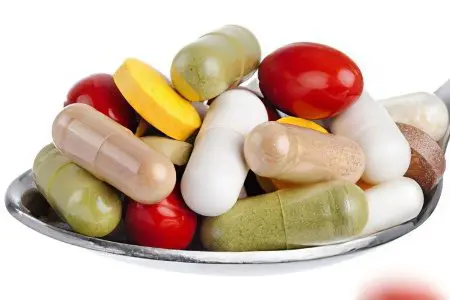
Diseases of the gallbladder are quite common. Among them are biliary dyskinesia and cholecystitis, all of which are often accompanied by chronic pancreatitis. And not only adults are affected, but also children. Symptoms of the pathology are not always obvious: there may be a decrease in appetite, mild nausea in the morning, pain in the right hypochondrium and skin itching. However, a person without a medical education is not always able to independently associate these signs of ill health with bile stasis. While even a slight delay in the diagnosis and treatment of the disease can be dangerous and lead to the formation of stones. To prevent this from happening, it is necessary to take choleretic drugs. Our article is devoted to these medicines.
Stagnation of bile – what is it?
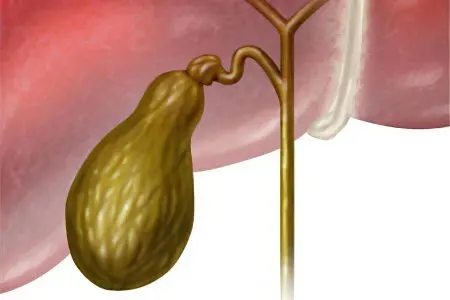
Some patients are firmly convinced that bile is produced and stagnates in the gallbladder. In fact, this is not entirely true. Bile is produced by hepatocytes, which are liver cells. From the liver, bile enters the gallbladder, where it reaches the concentration it needs by getting rid of excess water.
Bile comes out of the gallbladder at the moment when food containing fat enters the human stomach. The organ begins to contract and bile enters the duodenum through the bile ducts. The hole through which it exits is located in the immediate vicinity of the hole through which the pancreas ejects its enzymatic secret into the duodenum.
Bile is needed by the body to solve the following problems:
Bile dilutes fats to an emulsion, which facilitates the “work” of the enzymatic mixture. It will be much easier for enzymes to dissolve such a fraction.
Bile provides normal conditions for the work of pancreatic enzymes. Otherwise, they could not fully dissolve food into essential nutrients.
Bile causes the intestines to contract.
Bile makes it possible to absorb vitamins A, D, E and K, which are fat-soluble.
Bile prevents the penetration of pathogenic microorganisms into the blood. It simply does not allow them to attach to the intestinal walls, and they do not have the ability to be absorbed in the same way as food.
Bile helps to remove cholesterol, bilirubin and some hormones from the body. They pass through the liver and are excreted through bile along with feces.
Therefore, there is no doubt about the benefits of bile. However, in order for it to fully perform all its functions, it is necessary to provide conditions for its adequate formation and entry into the duodenum. If the body is unable to cope with this task, then choleretic drugs come to the rescue. However, this does not mean that all medicines can be taken indiscriminately.
There are 4 groups of choleretic drugs.
Each group has specific goals and objectives:
Group 1: choleretics. These drugs are aimed at increasing the production of bile.
Group 2: cholekinetics. They accelerate the excretion of bile from the liver ducts, so it reaches the duodenum faster.
Group 3: cholespasmolytics. These drugs relieve spasm from the bile ducts.
Group 4: cholelithogenic bile acid preparations. They are necessary in order to dilute too concentrated bile and prevent stones from forming in it. Also, drugs from this group provide the dissolution of small stones, which occurs due to changes in the properties of bile.
To choose one or another remedy, you need to know which particular process in the body is disturbed. Unjustified intake of choleretic drugs can only aggravate the situation. For example, why relieve a spasm from the bile ducts if they are in a relaxed state or force a diseased liver to produce more bile when it is already working “for wear and tear”.
Indications for taking choleretic drugs
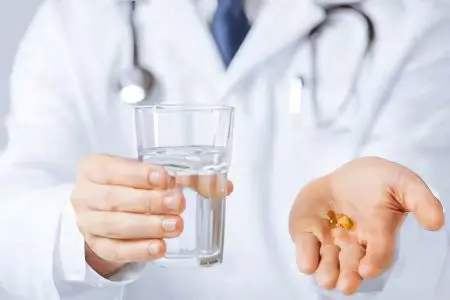
To understand which drug to choose and take, you need to understand the direction of movement of bile through the body.
Her path is as follows:
Bile is produced in the liver cells, after which it enters the intrahepatic bile ducts.
Through the intrahepatic pathways, bile enters the hepatic ducts (left and right). From them, it flows into the common hepatic duct, represented by a tube containing a minimal amount of muscle.
From this duct, bile enters the gallbladder through another duct, which is unable to contract, since it does not have a muscular basis. Bile needs some kind of force to overflow into its storage reservoir (gall bladder). It is a pressure drop: the pressure of the liver, when it produced bile, against the resistance of the sphincter of Oddi. This sphincter is represented by a round muscle, which is a continuation of the common hepatic duct. It leads to the duodenum. The sphincter of Oddi can be compared to a tap: if it is in the closed state, then the bile enters the cystic duct, straightens the muscleless folds and penetrates the gallbladder, where it begins to heat up.
When the gallbladder fills with bile, the pressure increases. At the same time, it decreases in the hepatic pathways. If food enters the human stomach, it begins to produce pepsin, which signals the sphincter of Oddi to open. Due to pressure drops, bile enters the duodenum, having the desired concentration, which it acquired in the gallbladder, getting rid of excess fluid.
When the pressure in the gallbladder increases to 250-300 mm of water column, the organ begins to contract on its own, which forces the sphincter of Oddi to open.
The common bile duct is deprived of the ability to contract, since it has practically no muscle fibers.
Knowing which path bile takes in the human body, you can understand the issue of choosing a drug.
Indication #1: Biliary dyskinesia
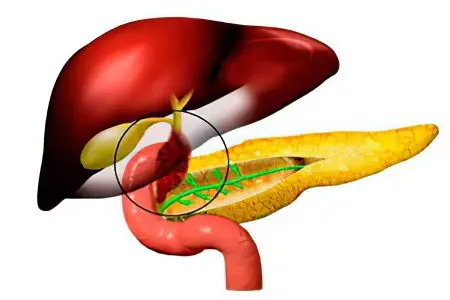
Dyskinesia means that the bile moves with violations, but which ones need to be dealt with.
Dyskinesia depends on several parameters:
The tone of the biliary tract. If it is normal, then no medications should be taken. If the tone is increased, then the bile will leave their bile ducts too quickly, which will lead to its reflux into the stomach. In this case, it is required to take drugs from the group of cholespasmolytics. When the tone of the biliary tract is too low, then bile will move slowly through them. Cholekinetic preparations are used to raise the tone.
The rate of contraction of the bile ducts. If they contract at a normal rate, no treatment is required. At a high rate of contraction, bile does not have time to gain the concentration it needs. To correct this condition, you will need to take antispasmodics. If the bile ducts, on the other hand, are reduced too slowly, then the bile will stagnate. In this case, a person needs to take either choleretics (more bile will be formed), or cholekinetics, which accelerate its movement.
So, the refined diagnosis of “biliary dyskinesia” can be as follows:
Hypertensive hyperkinetic dyskinesia. Most often, synthetic cholespasmolytics are prescribed.
Hypertensive normokinetic dyskinesia. In this case, the patient is prescribed cholespasmolytics of plant origin, which do not reduce the contractility of the biliary tract.
Hypertensive hypokinetic dyskinesia. In this case, bile cannot pass through the pathways due to their spasm, so it needs to be eliminated. In combination with an antispasmodic, cholekinetics are prescribed.
Hypotonic hypokinetic dyskinesia. To get rid of pathology, cholekinetics and choleretics are needed.
Hypotonic normokinetic dyskinesia. To eliminate this violation, a choleretic is required.
If you take drugs without understanding what is happening with bile in the body, then serious health problems can arise. Most people take choleretics, which stimulate bile production. However, they do not think about the consequences. After all, one cannot exclude the likelihood of an inflection of the gallbladder or hypokinetic dyskinesia. An excess of bile will cause the gallbladder to shrink very sharply, which causes severe pain. This pain is known as biliary colic.
In addition, a person can take cholespasmolytics. This will lead to stagnation of bile, in which salts will begin to accumulate in conjunction with cholesterol. Then they will precipitate, which will provoke the formation of stones. It is also impossible to exclude infection of bile with the further development of cholecystitis.
Indication #2: bile stasis
Drugs that are prescribed to eliminate stagnation belong to the group of cholekinetics and choleretics. However, before taking them, it is necessary to undergo an ultrasound scan to make sure that there are no stones in the bile ducts. When such deposits are absent, or their diameter does not exceed 3 mm, then the patient is prescribed drugs based on bile acids.
When bile stagnates in the liver and the patient develops itching, and the dermis itself acquires a yellow tint, choleretic drugs are required in combination with other drugs. Often, home treatment is inappropriate, and the patient is hospitalized.
Indication number 3: inflection of the gallbladder
With an inflection of the gallbladder, dyskinesia always develops. It can be hypokinetic and hypermotor. To eliminate this violation, cholespasmolytics, cholekinetics, as well as agents containing bile acids will be required. If the pathology is not in an acute stage, then the choice should be stopped on herbal medicines.
Also, it cannot be ruled out that the inflection of the gallbladder is characterized by hypomotor and hypokinetic dyskinesia. In this case, the patient is prescribed drugs from the group of cholekinetics. Although sometimes they are replaced by taking choleretics.
Indication #4: cholecystitis

Cholecystitis is an inflammation of the gallbladder itself.
To eliminate it, the following drugs are used:
Choleretics, which thin the bile, freeing it from infection. Thus, it seems to be able to refresh.
Cholespasmolytics, which reduce the intensity of pain and relieve spasm from the muscular wall of the gallbladder.
Cholelithogenic drugs that are used to prevent the formation of stones in the gallbladder.
To eliminate inflammation, antibiotics are required. Moreover, the use of antibiotics of different groups (2 medicines) is recommended.
Indication #4: Pancreatitis
Inflammation of the pancreas, which is called pancreatitis, leads to the fact that the enzymatic secret will be produced in large volumes. Bile stimulates the production of these enzymes, so in order not to aggravate the situation, you need to make sure that it is released little by little. You should also exclude the possibility of an unexpected release of bile. For this purpose, cholespasmolytics are prescribed. Their reception is indicated for both chronic and acute pancreatitis. So that during this period stones do not begin to form in the gallbladder (stagnation cannot be avoided), it is necessary to take drugs in parallel to dissolve them.
It is important to understand that inflammation of the pancreas is a serious pathology that requires medical supervision.
Indication number 5: removal of the gallbladder
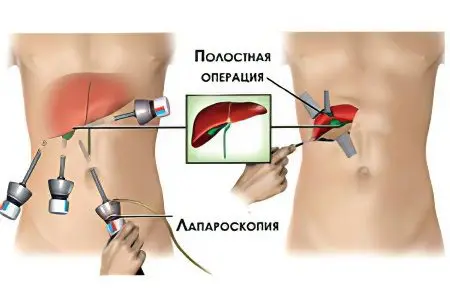
After the gallbladder is removed from the body, bile loses the place in which it could reach the concentration it needs. As a result, it enters the duodenum in a diluted form. However, stones can form even in such a low-concentration liquid. Therefore, all patients without exception are prescribed cholelithogenic drugs.
It is strictly forbidden to take choleretics after the operation, as this will lead to an increase in bile production.
For a period of 3 months (after undergoing cholecystectomy), patients are prescribed antispasmodics. The fact is that when the gallbladder was still present in the body, it worked with the sphincter of Oddi in tandem. The bladder contracted and the sphincter relaxed. After the organ is removed, the sphincter of Oddi is not able to do its job in the same coordinated manner as before. Therefore, his muscles simply undergo spasm. To relieve this spasm, it is necessary to take cholespasmolytics. If this is not done, then the spasm will turn into stenosis and the person will again fall on the surgical table.
Hypertonicity of the sphincter of Oddi requires the use of cholekinetics. In parallel, the patient should receive antibiotics, anti-inflammatory drugs and hepatoprotectors.
List of choleretic drugs for choleretics
All choleretics are divided into 2 types:
True choleretics. They increase the volume of bile, stimulating its formation in the liver. Depending on which substance underlies the drug, the following subspecies of true choleretics are distinguished:
Preparations based on bile acids. They are obtained from the bile of animals.
Preparations of synthetic origin, which are aimed at stimulating the formation of bile.
Herbal preparations that activate the processes that lead to the production of bile.
Hydrocholeretics. These drugs are aimed at increasing the volume of the gallbladder, as they dilute it with water.
Below will be presented drugs exclusively of synthetic or animal origin, as well as hydrocholeretics. Medicinal products based on herbal raw materials are displayed in a separate heading.
Allochol
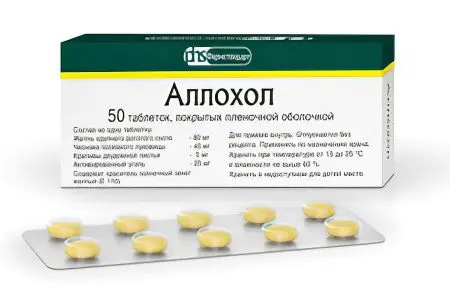
The drug is based on natural bile, it is also supplemented with components such as activated charcoal, garlic and nettle. Alternatively, such agents as Cholenzym (this drug has an addition in the form of enzymes), Festal (its composition is similar to the composition of Cholenzym) and Medical bile in the form of an emulsion can be used.
It is not always possible to use Allochol, it is not prescribed for exacerbation of hepatitis, and Festal and Cholenzym are not taken against the background of inflammation of the pancreas, with mechanical blockage of the biliary tract, and also against the background of dystrophic changes in the liver tissues.
Allohol has a number of advantages. The drug allows you to cleanse the liver, removes toxins from the body, quickly relieves the symptoms of dyskinesia. Allochol has been used as a medicine for many decades, so all its properties are thoroughly known to medicine. Allohol has been produced since 1964 and is a development of domestic specialists. This leads to a low cost of the drug and protection against fakes. Allochol is an extremely successful composition of plant and animal components, which allows you to solve many problems of the hepatobiliary system. In addition, the drug can be combined with other drugs, such as antiseptics, vitamins, laxatives. In addition to achieving a choleretic effect, Allohol is taken to prevent the formation of stones in the bile ducts.
As for the cons of Allochol, they boil down to the fact that this drug still has a number of contraindications. First of all, this is true for acute inflammation of the digestive system.
The price of the drug: from 10 to 60 rubles.
Odeston
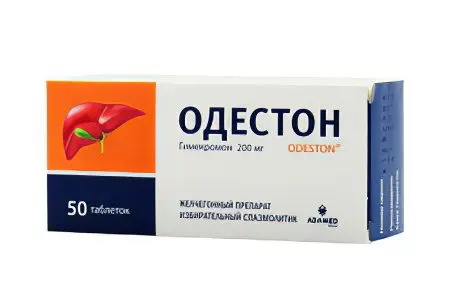
Odeston is based on Hymecromone. This substance is of synthetic origin. Analogues of this drug are medicines called Cholestil and Holonerton, but so far they are not on sale, as they are undergoing appropriate registration.
Odeston is not prescribed for blockage of the biliary tract, with Crohn’s disease, against the background of increased bleeding of the gums and stomach ulcers. You can not take Odeston with serious violations of the kidneys, as well as during breastfeeding.
The main advantage of the drug is that it has a double effect, that is, it acts as a choleretic drug (eliminates heaviness and pain in the right hypochondrium, relieves the taste of bitterness in the mouth, nausea) and as an antispasmodic (relaxes the bile ducts and sphincter Oddy). Odeston is dispensed in a pharmacy without a prescription.
As for the disadvantages of the drug, they include the presence of contraindications, in which the drug is prohibited to take. While biliary dyskinesia is often combined with various pathologies of the digestive system. Also, the disadvantages of Odeston include its high cost, which varies from 360 to 750 rubles, depending on the number of tablets in the package.
Nicodin
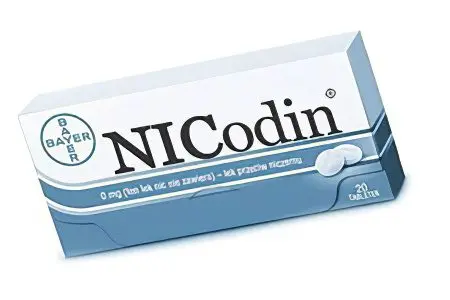
This is a drug based on a synthetic substance called Hymecromon. Similar medicines are drugs Cholestil and Holonerton.
Nicodin is not prescribed for blockage of the bile ducts, for gastritis with low acidity of gastric juice.
The advantage of the drug Nicodin is its pronounced choleretic effect. In addition, it has an antimicrobial and bactericidal effect, so it is prescribed for inflammation of the gallbladder. This means that Nicodin not only eliminates the symptoms of the disease, but also treats it.
At this point in time, this drug is at the stage of re-registration, so its cost is unknown. This is the most significant drawback of the drug. In addition, it is not prescribed for the treatment of pregnant women and children under 10 years of age.
In addition to the listed medicines, mineral waters that have an alkaline environment can be considered hydrocholeretics, among them:
Borjomi.
Slavyanovskaya.
Essentuki at numbers 4 and 17.
Jermuk.
Oil
List of choleretic drugs for cholekinetics
These drugs help to reduce the bile ducts. These include:
Magnesium Sulphate Powder

The composition of the drug contains magnesium in its pure form. Analogues are other preparations containing magnesium.
For treatment, it is necessary to dissolve 1 sachet in a liter of water and take this solution in a tablespoon 3 times a day.
Magnesium is not used for allergic reactions, as well as against the background of inflammatory processes in the intestines. Also, magnesium is not prescribed for cholelithiasis, during pregnancy and with obstruction of the paths for the outflow of bile.
The advantages of the drug include its low cost, which is 30 rubles, as well as ease of use.
The disadvantage of the drug is that it cannot be taken in the presence of gallstones. Therefore, without passing a medical examination, the use of the drug is unacceptable.
sorbitol

Sorbitol is the main active ingredient. The drug has no analogues. To provide a therapeutic effect, a tablespoon of Sorbitol is dissolved in 250 ml of warm water and taken orally. Then you need to place a warm heating pad under the right hypochondrium and lie down in this position for half an hour.
You can not take the drug with ascites, with irritable bowel syndrome, with inflammation of this organ.
The advantages of the drug include its rapid therapeutic effect, as well as low cost. For 350 g of powder, you will have to pay no more than 90 rubles.
The disadvantage of the drug is that it can provoke flatulence and diarrhea. If you take Sorbitol in large quantities, then this is associated with a risk of developing diabetic retinopathy and neuropathy. Moreover, it is contraindicated in obese patients.
List of cholespasmolytic drugs
Medicines in this group are:
Bellalgin
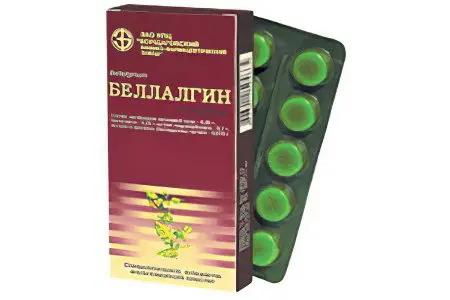
The composition of the drug includes belladonna extract, metamizole, soda and benzocaine. A similar preparation containing belladonna extract is Atropine.
Bellalgin is capable of causing serious side effects, so it is prescribed solely on medical advice. Most often, the patient is prescribed one tablet 2-3 times a day.
You can not take Bellalgin during pregnancy, against the background of tachycardia, with glaucoma, in violation of the liver and kidneys, against the background of impaired hematopoiesis.
The obvious advantage of the drug is its low cost. For a package of 10 tablets, you will need to pay 60 rubles. Besides the fact that it has an antispasmodic effect, the drug helps to eliminate pain.
The disadvantages of the drug include its multiple contraindications and side effects. Despite the fact that Bellalgin has an analgesic effect, it should not be taken for acute pain until the cause has been established.
Metacin
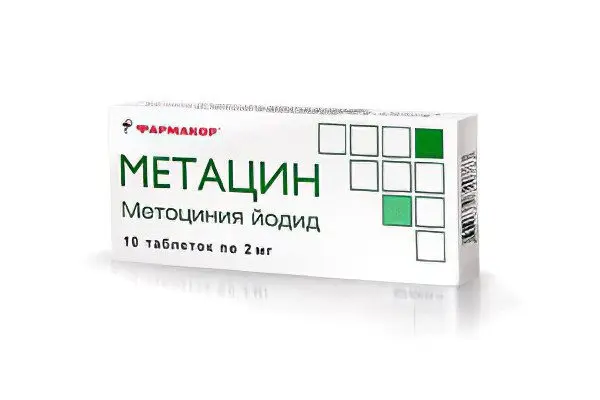
The basis of the drug is a substance called metocinium iodide. Metacin has no analogues. As a rule, patients are prescribed 1-2 tablets, 2-3 times a day.
You can not take the drug for diseases of the cardiovascular system, with reflux esophagitis, with a hernia of the diaphragm, against the background of renal and hepatic insufficiency.
The obvious advantage of the drug is that it can be prescribed for the treatment of pregnant women and children. In addition, Metacin has a pronounced analgesic effect, so it is allowed to be used to stop renal colic. The price of the drug is not high and is within 180 rubles.
The disadvantage of the drug is the presence of side effects, and quite serious ones, for example, accommodation paralysis, urinary retention and increased intraocular pressure.
Platifillin

The main active ingredient is platyfillin hydrotartrate. The drug has no analogues. It can only be used in the form of subcutaneous injections.
Platifillin should not be prescribed to patients with atherosclerosis, heart disease, diaphragmatic hernia, and against the background of bleeding from the stomach or intestines.
The advantages of the drug include its low cost (for 10 ampoules you will have to pay 70 rubles), the rapid elimination of pain and spasm. Also, this one has stood the test of time.
As for the disadvantages of Platifillin, they include soreness at the injection site. There is no possibility of oral administration, since the drug is released only in the form of a solution for injection.
Papazol

Papazol is a drug based on papaverine hydrochloride and bendazole. Similar drugs include Dibazol, Papaverine in suppositories and injections.
Take Papazol one tablet 2 or 3 times a day.
Do not use the drug to treat patients with low blood pressure, as well as in old age.
The advantages of the drug include its extremely low cost (10 rubles per package containing 10 tablets), as well as the combined effect. In addition to the antispasmodic effect, Papazol is able to stimulate the immune system, lower blood pressure and relax the vascular walls that are in hypertonicity.
The disadvantages of the drug can be considered the presence of contraindications and side effects. It is not prescribed to patients suffering from renal insufficiency. In addition, Papazol is able to interact with many drugs, so only a doctor can recommend taking it.
Drotaverine
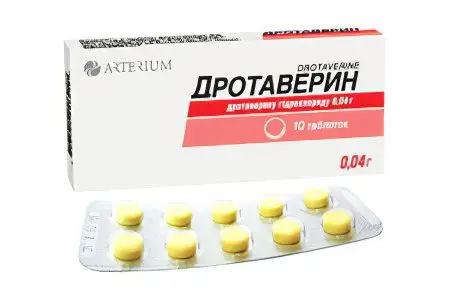
The main active ingredient is drotaverine. An analogue of this drug is No-shpa.
Take the drug 1-2 tablets no more than three times a day. Do not prescribe Drotaverine to patients suffering from atherosclerosis and glaucoma.
Drotaverine is an inexpensive drug of domestic origin, its cost does not exceed 70 rubles per pack. Also, the advantage of the drug is its speed, duration of the analgesic effect and high bioavailability, which is equivalent to 100%.
As for the disadvantages of Drotaverine, they include only the side effects that it can give. First of all, this concerns a sharp decrease in blood pressure and depression of the respiratory center. In childhood, the drug can only be used in tablet form.
Duspatalin
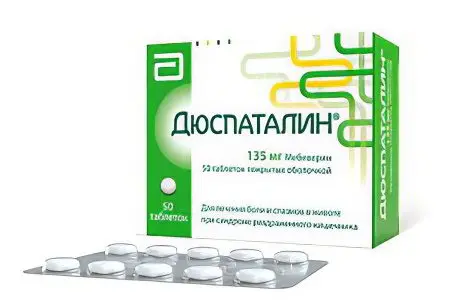
The main active ingredient is mebeverine. An analogue of Duspatalin is the drug Mebeverin. It is taken one capsule twice a day.
Do not prescribe the drug to children under 10 years of age, as well as to pregnant women.
As for the advantages of the drug, they include the rapid removal of spasm and a targeted effect. Duspatalin can be taken for two weeks without consulting a specialist, but provided that the person has no contraindications to it.
The disadvantages of the drug include its high cost and the presence of side effects. For packaging, you will need to pay from 510 to 600 rubles.
Eufillin
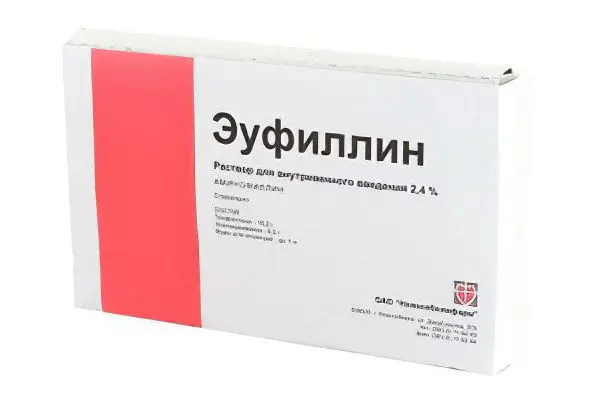
The main active ingredient is aminophylline. The analogue of Eufillin – the drug Aminophylline is currently under re-registration.
Patients are prescribed Eufillin 1 tablet 3 times a day.
You can not use the drug against the background of myocardial infarction, with arrhythmias and other heart diseases. It is not prescribed for acute stomach ulcers. It is also contraindicated in children under 6 years of age, patients with epilepsy and hyperthyroidism.
The price of Eufillin is low and amounts to 20 rubles. Also, the advantages of the drug include its speed and a small number of side effects.
The disadvantage of the drug is the presence of contraindications, which are mainly associated with diseases of the cardiovascular system. Therefore, it will simply not be possible to use Eufillin to relieve spasm and pain for most cardiological patients.
Galidor

The main active ingredient is benziklan. The drug has no analogues. It should be taken one tablet 3 times a day.
Do not prescribe the drug for myocardial infarction. It is contraindicated in people under the age of 18, as well as in patients with epilepsy and hyperthyroidism.
The advantages of the drug include the rapid provision of an analgesic effect. It can be used by patients suffering from cholecystitis and cholelithiasis. The drug is prescribed for people who have undergone surgery to remove the gallbladder and with dyskinesia of the sphincter of Oddi.
The disadvantage of Galidor is its high cost. For a package of 50 tablets, you will need to pay 550 rubles. In addition, the drug can not be used to treat pregnant and lactating women, as well as liver failure.
Buscopan
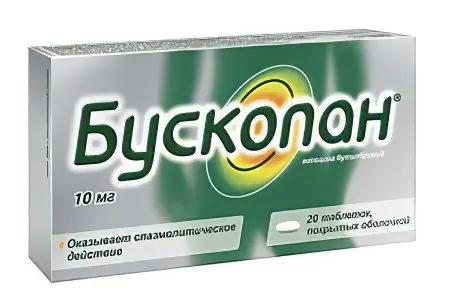
The main active ingredient is hyoscine. The drug has no analogues. It is not prescribed for urolithiasis, atherosclerosis and glaucoma.
The advantages of the drug include its pronounced antispasmodic effect (comes 15 minutes after ingestion) and a decrease in the production of digestive secretions, which is very important for choleretic drugs. At the same time, Buscopan does not affect the central nervous system.
The only drawback of the drug is its high cost. It varies in the range of 360-380 rubles.
List of cholelytic
Drugs from this drug group are used to prevent the formation of gallstones, as they reduce the concentration of cholesterol in bile. In addition, they can be used to dissolve small stones.
Choletics include:
Flowed.
Ursofalk.
Ursodeoxycholic acid.
Ursodez.
Grinterol.
Urdu.
The drug with the lowest cost is Ursodeoxycholic acid (600 rubles for 50 tablets). The most expensive drug is Ursofalk (915 rubles for 50 tablets).
Choletics are produced in the form of capsules. The daily dose is determined by the doctor. It depends on the weight of the patient and the presence of stones in the body.
Contraindications to taking cholelytics are: inflammation of the liver, inflammation of the gallbladder and bile ducts, pregnancy, lactation, calcium stones, biliary colic.
Cholagogue preparations of plant origin
Plant based choleretics
Name of the drug | Composition and analogues | How to use | Противопоказания | Cons and pros |
Flamin | Base: immortelle. The analogue is immortelle grass. | One tablet three times a day before meals. | The presence of stones larger than 10 mm, allergic reactions, age up to 3 years, mechanical jaundice. | Pros: two forms of release with different prices (granules cost 280 rubles, and tablets 180 rubles), a complex effect (antispasmodic, wound healing, antibacterial, choleretic, cholekinetic). Cons: there is no possibility to take the drug in patients with cholelithiasis and obstructive jaundice. |
Tanacehol | Base: tansy extract. Analog – Tansy flowers for brewing and tansy flowers in granules. | One or two tablets three times a day 20 minutes before meals | Allergic reactions. | Pros: low cost (30 rubles), quick antispasmodic effect, no side effects, except for allergic reactions. Cons: the drug can not be prescribed to patients with cholelithiasis. |
Berberis-gomakcord | Base: barberry in the form of drops. Analogues – Berberis vulgaris in granules. | 10 drops, three times a day 20 minutes before meals or 60 minutes after meals | Carrying a child. | Pros: the ability to eliminate inflammation in the gallbladder, the absence of contraindications, except for breastfeeding. Cons: the high price of the drug (550 rubles), the need for complex treatment. |
Holosas | Base: rosehip extract (syrup). Analog – Rosehip syrup, rose hips, Rosehip with vitamin C in syrup | teaspoon, 2 or 3 times a day. | Allergic reactions and cholelithiasis. | Pros: affordable price (from 70 to 120 rubles), saturating the body with vitamins, increasing immunity, relieving inflammation. Cons: the drug can only be used in a complex scheme with other drugs. |
Hofitol | Base: artichoke extract. Analog – Artichoke Extract. |
| The presence of stones in the gallbladder, liver and kidney damage in the acute stage, acute inflammation of the biliary tract and urinary tract. | Pros: pronounced choleretic effect, normalization of the liver, saturation of the body with B vitamins and vitamin C. Cons: high cost of the drug (from 120 to 300 rubles), |
Urolean | Ingredients: choleretic herbs. Analogue – Holagol. | The drug is applied to refined sugar in the amount of 8 drops and taken 3 times a day. | The presence of stones more than 3 mm, allergic reactions. | Pros: two forms of release (drops and capsules) Cons: high cost (310-350 rubles), the presence of contraindications for use, the inability to take the drug in the acute phase of the disease. |
Valerian tablets | Base: valerian extract. Analog – Valerian in tincture | 1-2 tablets 3-4 times a day. | Individual intolerance to the drug. | Pros: low cost, which starts from 45 rubles, the drug has an antispasmodic and choleretic effect. Cons: as an independent remedy, it has insufficient effectiveness, therefore it is required to take it in combination with other drugs. |
Cholekinetics of plant origin
Cholekinetics of plant origin include preparations that contain any vegetable oils, but olive, sunflower and caraway oils have the greatest effect. In the same group can be identified: fennel (fruits), calamus (roots and rhizomes), barberry leaves, cumin (fruits).
The drug Berberis-homaccord can also be attributed to plant cholekinetics, as it has multiple effects, including normalizing the bile ducts.
Cholespasmolytics of plant origin
The group of plant cholespasmolytics includes valerian, Cholagol, as well as herbs such as: calendula, St. John’s wort, tansy, arnica, turmeric root.
Cholagogue preparations for the treatment of children
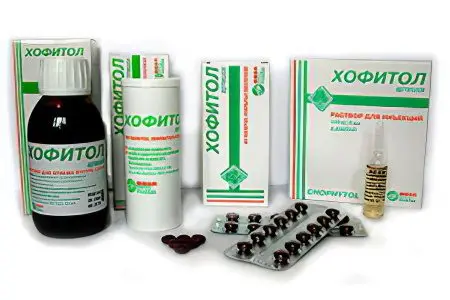
In childhood, the following choleretic drugs can be used:
From the age of 3, Holosas is prescribed.
From six months, you can use Papaverine and Atropine, but under strict medical supervision.
From the age of 6, Hofitol, Flamin and Eufillin are prescribed.
From the age of 7 you can take Urolesan.
From the age of 10, Duspatalin is allowed to receive.
However, before starting treatment, a specialist consultation is required.
The best choleretic drugs
Which drug is optimal should be determined by the doctor together with the patient.
Nevertheless, the observations of recent years make it possible to single out the best choleretic agents, depending on their group:
Choleretics: Nicodin, Urolesan, Holosas, Tanacehol.
Cholekinetics: Magnesium sulfate and Sorbitol.
Cholespasmolytics: Buscopan and Duspatalin, as they have a targeted effect on the biliary tract. While Papaverine and No-shpa relieve spasm from the smooth muscles of all organs.
[Video] President of the Sofya Dorinskaya Medical Center on “safe cholagogues”:









